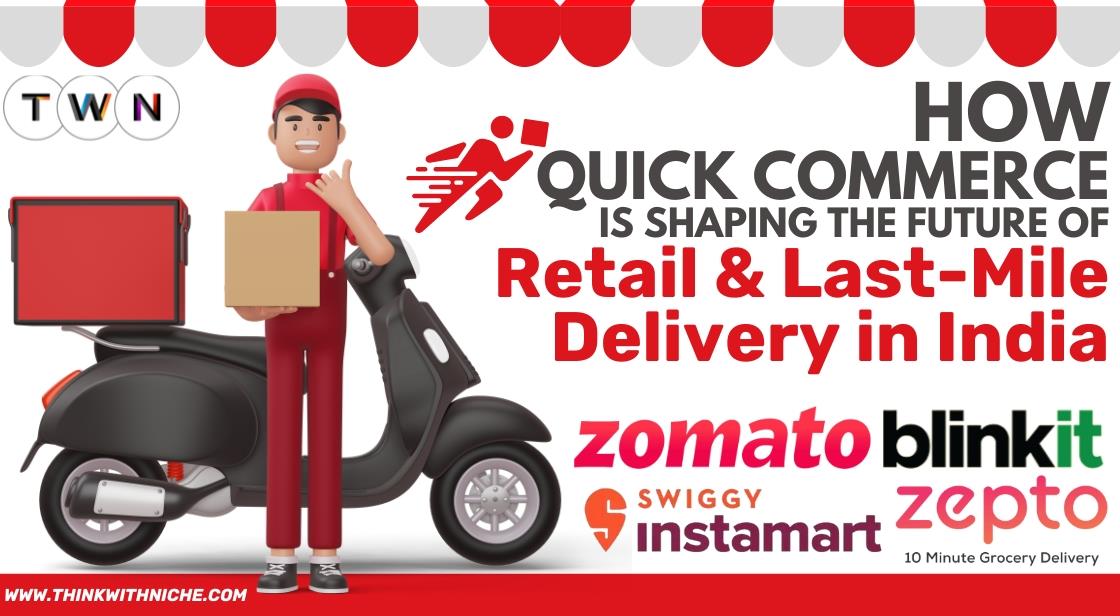How Quick Commerce is Shaping the Future of Retail and Last-Mile Delivery in India

Blog Post
In India, quick commerce is revolutionizing the retail and last-mile delivery sectors with unprecedented speed and efficiency. As the demand for rapid delivery escalates, this emerging trend has seen explosive growth, reshaping consumer expectations and market dynamics.
In 2023, the gross merchandise value (GMV) of quick commerce in India reached an impressive US$2.3 billion, marking a staggering 70% increase from the previous year.
This surge underscores the burgeoning appetite for instant delivery services and highlights the sector's potential, with projections indicating a compound annual growth rate (CAGR) of 27.9% from FY22 to FY27.
The COVID-19 pandemic catalyzed this transformation, accelerating a shift from traditional retail to quick commerce platforms that promise deliveries within 10-20 minutes.
Companies such as Zomato-owned Blinkit, Swiggy Instamart, Dunzo Daily, and the fast-emerging Zepto have become central players, driving this growth by meeting the evolving demands of urban consumers.
Leveraging advanced technologies like predictive analytics, real-time inventory management, and automation, these platforms are not only enhancing operational efficiency but also setting new benchmarks for speed and convenience in retail.
As quick commerce continues to expand beyond major cities into smaller towns, the sector's impact on the e-commerce landscape is becoming increasingly significant.
With an anticipated market value of US$5.5 billion by 2025, the sector is projected to capture a substantial share of the online grocery market, rising from 10% to approximately 45%.
This rapid evolution reflects a broader shift towards hyper-localized and technology-driven retail solutions, positioning quick commerce as a pivotal force in the future of Indian retail and last-mile delivery.
Quick Commerce and Last-Mile Delivery: The Future of Retail in India
Revolutionizing Retail with Quick Commerce
Quick commerce, often referred to as Q-commerce, is at the forefront of the retail revolution in India. By focusing on speed and convenience, it has disrupted the traditional retail sector, which primarily relied on physical stores and slower delivery models. The advent of quick commerce has created a new expectation among consumers for instant gratification, where they can order groceries, medicines, and even electronics with the assurance of receiving them within minutes.
The COVID-19 pandemic significantly hastened this transition. As lockdowns and social distancing measures restricted in-store shopping, consumers increasingly turned to online platforms for their daily needs. Quick commerce platforms, with their promise of fast delivery, became the go-to solution for urban consumers who needed essentials delivered quickly. This shift in consumer behavior led to a significant surge in demand for quick commerce services, propelling the sector to new heights.
The Rapid Expansion of Quick Commerce in India
The growth of quick commerce in India has been nothing short of extraordinary, marking a significant transformation in the retail and delivery landscape. Quick commerce, characterized by ultra-fast delivery services, has seen unprecedented expansion in recent years, driven by a combination of technological advancements, shifting consumer preferences, and changing market dynamics.
Impressive Growth Metrics of Quick Commerce in India
In 2023, the gross merchandise value (GMV) of quick commerce in India surged to an impressive US$ 2.3 billion, reflecting a remarkable growth of over 70% from the previous year. This dramatic rise underscores the increasing consumer demand for speedy delivery services and the rapid adaptation of businesses to meet these needs.
The sector’s growth trajectory is projected to continue at a robust pace, with forecasts suggesting a compound annual growth rate (CAGR) of 27.9% from FY22 to FY27. This growth rate signifies not only the expanding market potential but also the evolving consumer expectations for faster and more efficient delivery solutions.
Key players of Quick Commerce in India
Several major players have been pivotal in driving the quick commerce industry ahead, encompassing both well-established platforms and innovative newcomers:
Zomato-owned Blinkit:
Originally known as Grofers, Blinkit has emerged as a dominant player in the quick commerce sector. With its focus on delivering groceries and essentials in under 10 minutes, Blinkit has rapidly expanded its reach across major cities in India, including Delhi, Mumbai, and Bengaluru.
Swiggy Instamart:
Swiggy, a leading food delivery platform, has leveraged its extensive network to establish Instamart, which provides fast delivery of groceries and daily essentials. Instamart has quickly gained traction in urban areas, further cementing Swiggy’s position in the quick commerce space.
Dunzo Daily:
Dunzo, known for its hyperlocal delivery services, has also ventured into the quick commerce sector with Dunzo Daily. This platform focuses on delivering a wide range of products, from groceries to medicines, in a matter of minutes, addressing the growing demand for instant deliveries.
Country Delight:
Specializing in dairy products, Country Delight has tapped into the quick commerce market by offering fresh milk and other dairy items with rapid delivery times. This niche focus has helped Country Delight cater to a specific segment of consumers seeking high-quality, fresh products delivered quickly.
Zepto:
A notable new entrant, Zepto has quickly made a mark with its promise of delivering groceries and essentials in as little as 10 minutes. The company’s aggressive expansion strategy and emphasis on speed have positioned it as a significant player in the quick commerce landscape.
Technological Innovations and Market Expansion
The growth of quick commerce is heavily influenced by advancements in technology and innovative business models. Companies in this sector have adopted cutting-edge technologies to enhance their operations and meet consumer expectations for rapid delivery. Key technological innovations include:
-
Advanced Algorithms: Predictive algorithms help platforms anticipate consumer demand and optimize inventory management. By analyzing purchasing patterns and historical data, these algorithms ensure that high-demand items are readily available, reducing delivery times.
-
Data Analytics: Platforms use data analytics to streamline delivery routes and improve efficiency. By analyzing traffic patterns and delivery locations, companies can optimize routes to ensure timely deliveries and minimize delays.
-
Automation and Robotics: Automation in warehouses, including the use of robotics, has significantly improved the speed and accuracy of order fulfillment. Automated systems handle sorting and packing, allowing for faster processing of orders.
Quick Commerce Expansion into New Markets
The quick commerce sector in India has expanded beyond major metropolitan areas to include smaller cities and towns. This expansion is driven by the increasing penetration of smartphones and internet connectivity, which has facilitated the growth of e-commerce in previously underserved regions. The shift from central warehouses to a network of micro-warehouses or dark stores has also enabled companies to offer faster delivery times in these new markets. These micro-warehouses, strategically located near delivery points, act as localized hubs for high-demand items, ensuring that consumers receive their orders promptly.
Also Read: How to Select the Most Suitable Investors for Your Business
The Role of Technology in Quick Commerce
Technology plays a pivotal role in the success of quick commerce platforms, enabling them to deliver on their promise of ultra-fast and efficient delivery services. Advanced technologies are employed to optimize various aspects of the quick commerce process, from predicting consumer demand to streamlining warehouse operations.
Predictive Analytics and Inventory Management:
-
Demand Forecasting: Sophisticated algorithms analyze historical data, consumer behavior, and external factors to accurately predict demand patterns.
-
Inventory Optimization: Based on demand forecasts, platforms can optimize their inventory levels, ensuring that popular products are readily available while minimizing stockouts and excess inventory.
-
Real-time Inventory Tracking: Advanced inventory management systems provide real-time visibility into stock levels, enabling platforms to make informed decisions about replenishment and allocation.
Route Optimization and Delivery Efficiency:
-
Advanced Algorithms: Cutting-edge algorithms analyze factors such as traffic conditions, customer locations, and delivery distances to determine the most efficient routes for delivery drivers.
-
Real-time Tracking: GPS technology enables platforms to track the location of delivery vehicles in real-time, allowing for efficient rerouting and updates to customers.
-
Last-Mile Optimization: Quick commerce platforms focus on optimizing the last-mile delivery process, ensuring that orders are delivered promptly and accurately to customers' doorsteps.
Automation and Robotics:
-
Warehouse Automation: Automated systems such as robotic arms and conveyor belts can significantly improve the speed and accuracy of warehouse operations, reducing the risk of errors and increasing efficiency.
-
Order Picking and Sorting: Automated systems can pick and sort orders based on customer requirements, minimizing human error and speeding up the fulfillment process.
-
Inventory Management: Robotics can be used to automate tasks such as inventory replenishment and stocktaking, reducing labor costs and improving accuracy.
Integration of Technologies:
-
Unified Platforms: Quick commerce platforms often integrate various technologies, such as GPS tracking, IoT devices, and AI-powered chatbots, to create a seamless and efficient customer experience.
-
Data-Driven Insights: By leveraging data analytics, platforms can gain valuable insights into consumer behavior, preferences, and trends, enabling them to make data-driven decisions and improve their services.
In conclusion, technology is the driving force behind the success of quick commerce platforms. By harnessing the power of advanced algorithms, automation, and data analytics, these platforms can deliver on their promise of ultra-fast and efficient delivery services, revolutionizing the retail landscape.
The Evolution of Last-Mile Delivery
One of the most significant impacts of quick commerce has been on last-mile delivery, the final leg of the delivery process where goods are transported from a distribution center to the end consumer. Traditionally, last-mile delivery has been a challenging and costly aspect of logistics, but quick commerce has introduced innovative solutions to address these challenges.
The shift from a singular central warehouse model to a network of micro-warehouses or dark stores has been a game-changer for the industry. These micro-warehouses, strategically located near delivery points, function similarly to neighborhood 'Kirana' stores, stocking a focused selection of high-demand items. This proximity to customers enables platforms to fulfill orders within 10-20 minutes, meeting the growing consumer demand for speed and convenience.
The Emergence of Quick Commerce in India: A Revolutionary Shift in E-commerce
Quick commerce has redefined the e-commerce landscape in India, expanding beyond traditional ready-made meals to include a wide array of items such as groceries, medicines, cosmetics, and electronics. This expansion has been driven by changing consumer preferences, particularly in urban areas where busy lifestyles and the need for convenience have made quick commerce an attractive option.
Key factors such as convenience, urbanization, and the increasing penetration of smartphones and internet access have all contributed to the rise of quick commerce. The pandemic further accelerated this trend, as consumers sought safe and convenient alternatives to in-store shopping. As a result, the quick commerce industry is projected to reach US$ 5.5 billion by 2025, with its contribution to the online grocery market expected to rise from 10% to approximately 45%.
The Advantages of Quick Commerce for Retailers
Beyond offering convenience to consumers, quick commerce provides significant benefits to retailers. In a competitive e-commerce landscape, the ability to offer faster delivery services gives retailers a crucial edge. Customer loyalty is closely tied to positive experiences with a platform, including the quality of products and the speed of delivery. Satisfied customers are more likely to remain loyal to a platform, helping to drive customer acquisition and retention.
Moreover, the data generated by quick commerce platforms is invaluable for retailers, offering deep insights into consumer behavior. By analyzing this data, retailers can better understand buying patterns, seasonal trends, and regional preferences, allowing them to tailor their offerings to meet the needs of their customers more effectively.
Growth Drivers of the Quick Commerce Market
Key Drivers of Quick Commerce Growth:
Changing Consumer Behavior: The pandemic accelerated the shift towards online shopping, with consumers increasingly seeking convenience and speed.
Quick commerce platforms offered a compelling solution by providing rapid delivery of essential goods.
Technological Advancements: The availability of advanced technologies, such as smartphones, internet connectivity, and location-based services, has played a crucial role in enabling quick commerce. These technologies facilitate efficient order processing, real-time tracking, and optimized delivery routes.
Urbanization and Lifestyle Changes: The growing urban population and busy lifestyles have contributed to the demand for quick and convenient shopping options. Quick commerce platforms address this need by offering instant delivery of essential items.
Government Initiatives: Government initiatives such as Digital India, Start-up India, and the Unified Payments Interface (UPI) have created a favorable environment for the growth of quick commerce.
New User Adoption: As quick commerce platforms continue to deliver on their promise of fast, reliable service, more consumers are redirecting their e-commerce spending towards these platforms. Millennials and Generation Z, particularly those living in major cities like Bengaluru, Delhi NCR, and Mumbai, are the primary drivers of this trend. Existing users are also increasing their spending on quick commerce platforms, reinforcing the shift towards instant purchases.
Event Days and Category Diversification: Quick commerce platforms have excelled in leveraging event days to boost sales. Platforms like Swiggy Instamart and Blinkit have recorded unprecedented sales during events such as Diwali, New Year's Eve, and sporting events like the Cricket World Cup.
In addition to groceries and essentials, quick commerce platforms have expanded their offerings to include beauty products, electronics, home decor, and more. This category diversification has positioned quick commerce platforms as direct competitors to traditional e-commerce giants, offering greater convenience to consumers across a wide range of categories.
Government Initiatives Boosting Quick Commerce in India
The growth of quick commerce in India has been significantly supported by various government initiatives that have created a favorable environment for the industry. These initiatives have addressed key challenges such as infrastructure, digital literacy, and payment systems, paving the way for the rapid expansion of quick commerce platforms.
Digital India:
-
Enhanced Digital Infrastructure: The Digital India initiative has played a pivotal role in improving India's digital infrastructure, including broadband connectivity and internet penetration. This has enabled wider access to online services, including quick commerce platforms.
-
Digital Literacy: Digital India has also focused on increasing digital literacy among the population, empowering consumers to utilize online platforms effectively. This has contributed to the adoption of quick commerce services.
Start-up India:
-
Favorable Environment: Start-up India has created a supportive environment for new-age start-ups, providing incentives, mentorship, and funding opportunities. This has encouraged entrepreneurs to explore the quick commerce space and launch innovative ventures.
Skill India:
-
Talent Development: Skill India has focused on developing the necessary skills and talent within the workforce to support the growth of the quick commerce industry. This includes training in areas such as logistics, technology, and customer service.
Unified Payments Interface (UPI) and RuPay:
-
Digital Payments: UPI and RuPay have revolutionized digital payments in India, making it easier and more convenient for consumers to make online transactions. This has facilitated the adoption of quick commerce platforms, which often rely on digital payments.
BharatNet:
-
Broadband Access: BharatNet has played a crucial role in expanding broadband connectivity to rural and underserved areas. This has enabled more people to access the internet and utilize quick commerce services.
Open Network for Digital Commerce (ONDC):
-
Fair Competition: ONDC has promoted fair competition within the e-commerce ecosystem by onboarding smaller vendors onto digital platforms. This has provided opportunities for local businesses to participate in the quick commerce market.
Other Initiatives:
-
100% FDI in B2B Models: The government has allowed 100% Foreign Direct Investment (FDI) in entities engaged in business-to-business (B2B) models. This has encouraged foreign players to invest in and contribute to the growth of the quick commerce industry in India.
Government initiatives have played a vital role in fostering the growth of quick commerce in India. By addressing infrastructure challenges, promoting digital literacy, and facilitating digital payments, these initiatives have created a conducive environment for the development of quick commerce platforms. As the industry continues to evolve, ongoing government support will be essential for its sustained growth and success.
The Road Ahead: The Future of Quick Commerce in India
The rise of quick commerce represents a fundamental shift in India's retail industry. As consumer behavior continues to evolve and technology advances, quick commerce is set to play an increasingly prominent role in shaping the future of retail and last-mile delivery. The industry is poised for significant growth, with vast opportunities for investment and innovation.
However, the success of quick commerce companies will depend on their ability to manage delivery infrastructure efficiently and cost-effectively. Companies will need to prioritize growth in major cities, implement delivery fees for smaller orders, and explore new revenue streams such as advertising and partnerships with fast-moving consumer goods (FMCG) companies. Sustainability will also be a key consideration, as quick commerce platforms seek to balance the need for speed with the importance of environmental responsibility.
Conclusion
In conclusion, quick commerce is not just a fleeting trend but a transformative force reshaping the landscape of retail and last-mile delivery in India. The sector's phenomenal growth, with a projected market value of $5.5 billion by 2025, highlights the shifting consumer expectations for speed and convenience.
As companies like Blinkit, Swiggy Instamart, and Zepto continue to innovate and expand, they are setting new standards for instant delivery services, catering to the fast-paced demands of urban consumers. Technological advancements, such as predictive analytics and automation, are critical in driving this evolution, enabling platforms to deliver ultra-fast services efficiently.
Moreover, the supportive role of government initiatives and the increasing penetration of smartphones and internet access are fueling the expansion of quick commerce into new markets.
As the sector continues to grow, it will be crucial for companies to balance speed with sustainability and cost-effectiveness, while exploring new revenue streams and adapting to changing consumer behaviors. The future of quick commerce in India promises exciting opportunities and challenges, marking a new era in retail that prioritizes instant gratification and unparalleled convenience.
You May Like
EDITOR’S CHOICE












